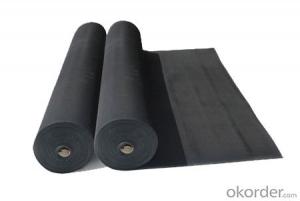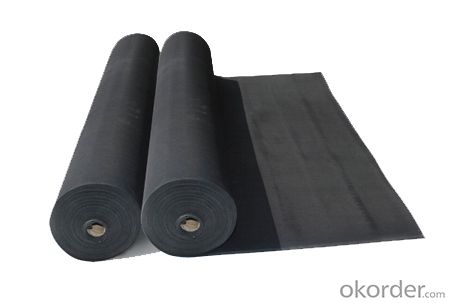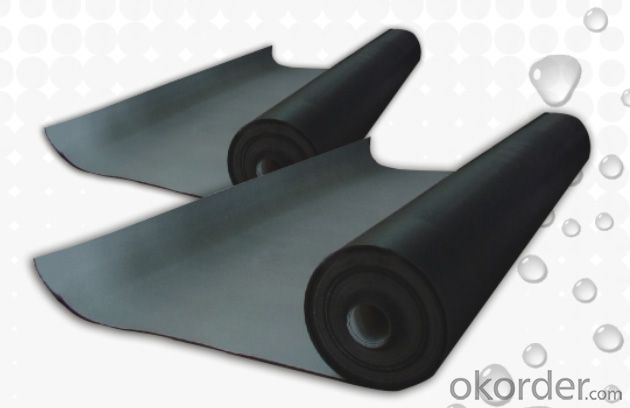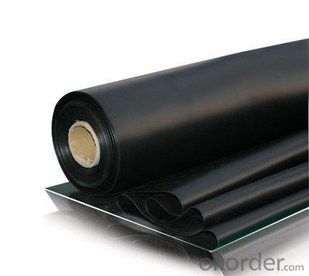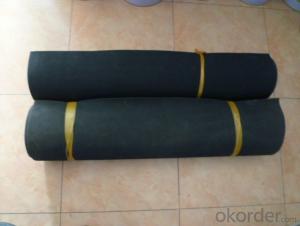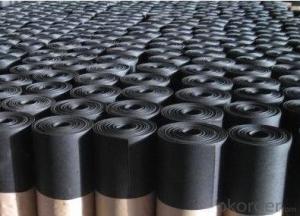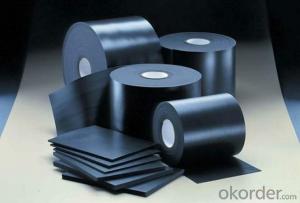EPDM Coiled Rubber Waterproof Membrane for Road
- Loading Port:
- Shanghai
- Payment Terms:
- TT OR LC
- Min Order Qty:
- 50000 m²
- Supply Capability:
- 5000000 m²/month
OKorder Service Pledge
OKorder Financial Service
You Might Also Like
EPDM Coiled Rubber Waterproof Membrane for Road
Description Of EPDM Coiled Rubber Waterproof Membrane for Road:
•EPDM waterproof sheet has excellent anti-ozone-aging performance, able to resist ultraviolet light and corrosion of many chemical corrosive materials in the atmosphere
•It has high tensile strength, high ductility and strong retractility, it has excellent crack resistance, able to effect waterproof function even with tiny vibration of buildings.
• Excellent resistance to ozone, oxidation and sunlight.
• Resistance to chemicals; resistant to most inorganic products.
Main Features of EPDM Coiled Rubber Waterproof Membrane for Road:
A.Polyester based SBS Modified Bitumen Waterproofing Membrane
a. Strong impermeability
b. High tensile strength, elongation, ability to adapt the grassroots shrinkage deformation and cracking
c. Puncture-resistant, broken resistant, tear-resistant
d. The corrosion resistance, resistance to mildew, weathering good
e. Construction convenient, hot-melt can be operated Four Seasons Construction, reliable joints
Specifications of EPDM Coiled Rubber Waterproof Membrane for Road:
| Material | EPDM Rubber |
| Size | 1.2m (width)*20m (length) or customized, weldable type 2.05m or 4m width |
| Thick | 1.2mm, 1.5mm, 2.0mm |
| Type | Vulcanized & Weldable |
| Pattern | Non-reinforced (homogeneous) |
| Certificate | ISO9001/14001 |
Applications of EPDM Coiled Rubber Waterproof Membrane for Road:
1. The substratum should be smooth, dry, clean, which can not have loosing and peeling phenomena.
2. Before application, clean up the basic level and eradicate the impurities.
3. Spread out the membrane on the substratum to loose sheet's stress. Use adhesive-glue to paint the substratum and the surface of membrane. When the adhesive is not sticky to hands, pave and press smoothly.
4. When pave the second volume of membrane, extrude 100mm of the edge of overlap of the first roll and do not paint with the adhesive. Pave the membrane on the substratum according to step so as to finish the whole pavement. When paving, do not tighten the waterproof membrane violently.
5. After that, use the special solvent to scrub the overlap joint. When it becomes fully dry , use the sheet glue to paint the both sides of the joint. Paint it again when it gets completely dry. Till the adhesive is not sticky to hands, press it smoothly and solidly.
6. Pay attention to fire prevention during application. Basement construction site shall be equipped with ventilation facilities



IMages of EPDM Coiled Rubber Waterproof Membrane for Road:




FAQ of EPDM Coiled Rubber Waterproof Membrane for Road:
1. What are we supplying?
We are specialized in producing Colorful Asphalt Roof Shingle, SBS/APP modified bitumen waterproof membrane, Self adhesive bitumen waterproof membrane, PVC waterproofing membrane, EPDM rubber roofing membrane, Single Component Polyurethane Waterproof Coating, and Spray Polyurea Waterproof Coating
.
2. How Many years experience do we have?
We have been exported to more than 20 countries in the past 15 years.
3. How long do we usually reply your request?
We always reply our customer within 24 hours.
- Q: Why the roof of the waterproof membrane and insulation rock wool board to do between the isolation layer?
- 3, in the insulation layer on whether to protect the isolation layer according to the construction of the insulation layer on the destruction of the role of the waterproof layer. Since the waterproofing membrane has been completed construction, indicating that the flatness has reached a higher demand, and the insulation layer of the grass-roots flatness requirements do not exceed the requirements of the web paving, so waterproof surface without leveling layer, but may need to do protection Isolation layer.
- Q: Are waterproofing membranes suitable for exterior use?
- Waterproofing membranes are indeed suitable for use on the exterior. These specific membranes are designed to create a barrier against the infiltration of water and are commonly employed in a range of outdoor applications such as rooftops, balconies, and foundations. They are constructed from durable materials capable of withstanding exposure to harsh weather conditions, UV rays, and temperature fluctuations. By preventing water damage, moisture accumulation, and potential structural problems caused by water infiltration, these membranes offer valuable protection. Furthermore, they can be applied to a variety of surfaces including concrete, metal, and wood, making them highly versatile for different outdoor environments. In summary, waterproofing membranes present a reliable solution for safeguarding exterior surfaces from water damage and extending their lifespan.
- Q: Are waterproofing membranes easy to install?
- Waterproofing membranes are generally easy to put in place. They can be found in various forms, such as sheets, rolls, or liquid coatings, which allows them to adapt to different surfaces and uses. Typically, the process involves cleaning and preparing the surface, applying the membrane, and ensuring a proper seal. While some technical knowledge and tools may be necessary, manufacturers often provide detailed instructions and guidelines for installation, making it easier for professionals and DIY enthusiasts alike. Furthermore, advancements in technology have resulted in the creation of self-adhesive membranes, which make the installation process even simpler. All in all, with proper preparation and following the correct installation procedures, waterproofing membranes can be installed relatively effortlessly.
- Q: Can a waterproofing membrane be used for a swimming pool deck?
- Yes, a waterproofing membrane can be used for a swimming pool deck. Waterproofing membranes are designed to provide a barrier against water infiltration, which makes them suitable for protecting the pool deck from water damage and ensuring its longevity.
- Q: Can a waterproofing membrane be used in elevator pits or sump pits?
- Yes, a waterproofing membrane can be used in elevator pits or sump pits to prevent water infiltration and protect the structure from potential damage caused by moisture.
- Q: Can a waterproofing membrane be used on precast insulation surfaces?
- Yes, a waterproofing membrane can be used on precast insulation surfaces. The membrane acts as a protective barrier, preventing water penetration and ensuring the insulation remains dry and functional.
- Q: Can a waterproofing membrane be used on below-grade walls?
- Yes, a waterproofing membrane can be used on below-grade walls. In fact, it is highly recommended to use a waterproofing membrane on below-grade walls to protect them from water infiltration and moisture damage. Below-grade walls are particularly vulnerable to water penetration due to their proximity to the ground and potential for hydrostatic pressure. A waterproofing membrane acts as a barrier, preventing water from seeping into the walls and causing issues such as mold, mildew, rot, and structural damage. It helps to keep the interior of the building dry, preventing potential moisture-related problems.
- Q: Are waterproofing membranes resistant to efflorescence?
- In general, waterproofing membranes have a resistance to efflorescence. This refers to the white residue that can be seen on the surface of materials like concrete, brick, or stone when salts migrate to the surface. The purpose of waterproofing membranes is to form a barrier that blocks water and moisture from entering the material and carrying salts to the surface. By effectively preventing water from entering, waterproofing membranes reduce the occurrence of efflorescence and provide long-lasting protection against it. However, it is important to consider that the effectiveness of a waterproofing membrane in preventing efflorescence can vary depending on factors such as the quality and application of the membrane, environmental conditions, and the presence of underlying issues like water infiltration or inadequate drainage.
- Q: Can a waterproofing membrane be used for a parking garage?
- Yes, a waterproofing membrane can be used for a parking garage. Waterproofing membranes are commonly used in underground structures such as parking garages to prevent water infiltration and protect the structure from potential damage caused by moisture.
- Q: Are there any special tools required for installing a waterproofing membrane?
- Yes, there are some special tools required for installing a waterproofing membrane. Some of these tools may include a trowel or a roller for spreading the membrane, a utility knife for cutting the membrane to size, a primer to prepare the surface before installation, and a squeegee or a brush for smoothing out any air bubbles or wrinkles in the membrane. Additionally, depending on the specific type of waterproofing membrane being used, there may be other specialized tools or equipment required.
Send your message to us
EPDM Coiled Rubber Waterproof Membrane for Road
- Loading Port:
- Shanghai
- Payment Terms:
- TT OR LC
- Min Order Qty:
- 50000 m²
- Supply Capability:
- 5000000 m²/month
OKorder Service Pledge
OKorder Financial Service
Similar products
Hot products
Hot Searches
Related keywords
